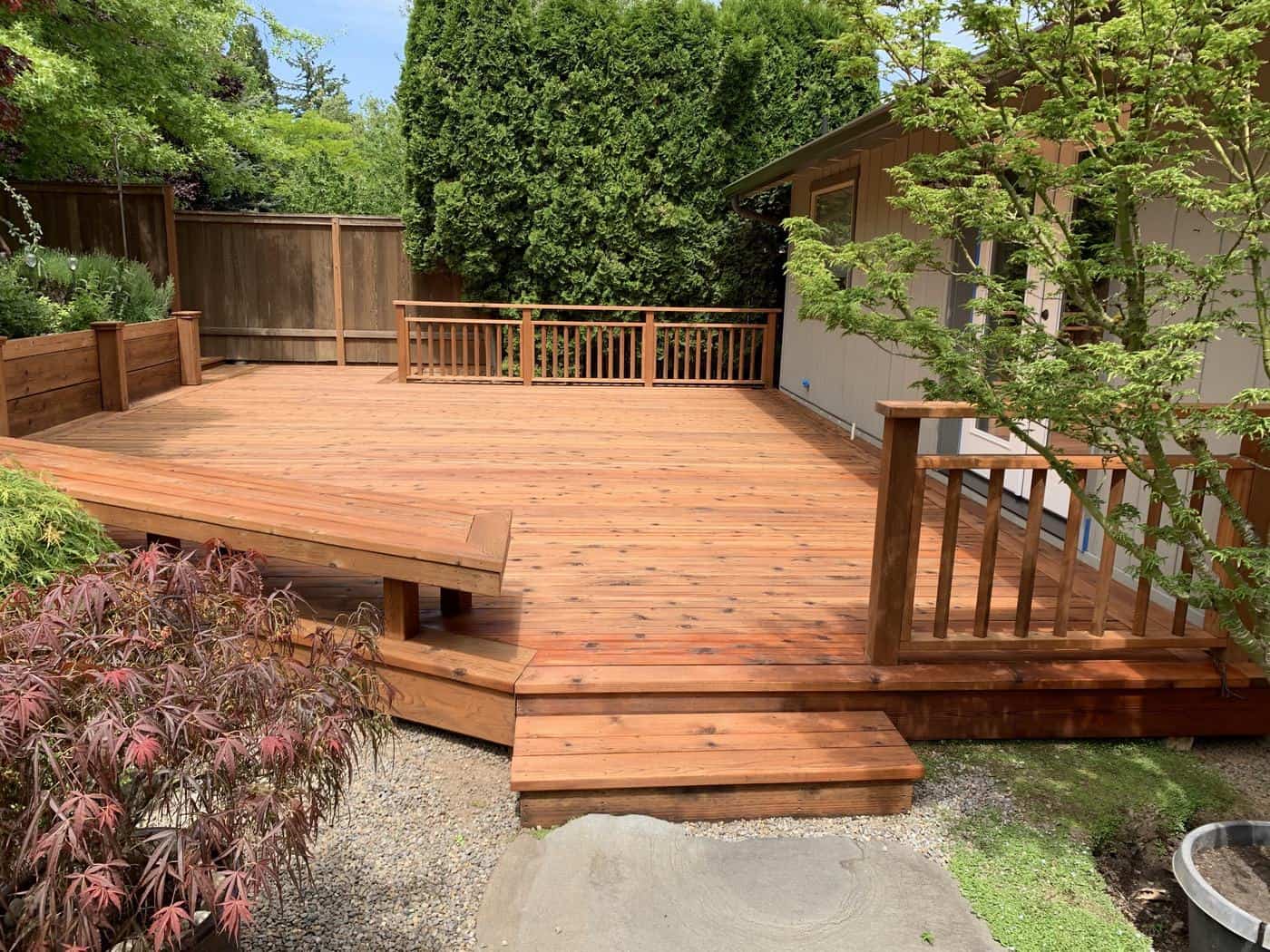Deck Staining Marvels: Changing Your Outside Oasis
Deck Staining Marvels: Changing Your Outside Oasis
Blog Article
Selecting the Right Stain for Your Fence: Tips and Considerations
When it comes to boosting the appearance and preserving of your fence, choosing the best discolor is crucial. We will discover the various types of fence discolorations, variables to consider before selecting a stain, pointers for preparing your fencing for discoloration, and the differences between oil-based and water-based spots. Furthermore, we will dive into selecting the best discolor shade to enhance your fencing and enhance your outside area.
Understanding Various Kinds of Fence Spots

On the other hand, water-based spots are made from acrylic or latex and offer a much more refined color to the timber. They create a safety movie externally of the wood, protecting against moisture from leaking in and securing versus UV damages. Water-based stains are simpler to tidy up and have a quicker drying out time contrasted to oil-based discolorations. They are also less likely to fade or crack over time.
Picking between water-based and oil-based stains depends upon different aspects, consisting of individual choice, the preferred appearance, and the level of maintenance required. Oil-based stains are recommended for surround high-traffic areas or those continuously subjected to extreme weather. deck staining. Water-based discolorations, on the various other hand, are a preferred selection for surround household locations where appearance and simplicity of use are very important
When selecting the appropriate tarnish for their fencing,Comprehending the differences in between water-based and oil-based spots assists house owners make a notified decision. Considering the specific needs of the fencing, such as its area, direct exposure to sunshine, and desired aesthetic, will certainly make sure that the chosen tarnish offers long-lasting defense and enhances the total elegance of the fencing.
Elements to Take Into Consideration Prior To Selecting a Stain

One more element to consider is the kind of timber your fence is made of. Different sorts of timber take in stains differently, resulting in differing levels of color strength and longevity. As an example, softwoods like yearn might need more regular staining contrasted to hardwoods like cedar or redwood. In addition, specific timbers may be more vulnerable to concerns like rot or insect invasion, which may impact the choice of tarnish to protect the fence and secure.
The environment and weather in your area ought to likewise be taken into account. You might require a tarnish that gives added defense versus wetness and UV rays if you live in a location with extreme wintertimes or high humidity. Similarly, if your fencing is subjected to guide sunlight for extended periods, a tarnish with UV preventions can aid protect against fading and staining.
Finally, it is essential to consider your preferred aesthetic. Various discolorations use different colors and coatings, permitting you to personalize the appearance of your fence (fence staining and sealing). Take into consideration the total design and style of your residential property, in addition to any type of local laws or house owner association standards that might dictate the appropriate discolor colors
Tips for Readying Your Fence for Staining
Cleansing the fence is a vital step as it gets rid of dirt, crud, and any type of previous coatings that may conflict with the staining process. Rub the surface area gently, paying additional interest to locations with stubborn spots or mold and mildew.
After cleansing, enable the fencing to completely dry completely. fence staining and sealing. This action is essential as discoloring a wet or wet surface can cause poor bond and an irregular coating. Depending upon the weather conditions, it may take anywhere from a couple of hours to a few days for the fence to completely dry extensively. Ensure that the fence is entirely dry before waging the discoloration process.
Before staining, examine the fence for any type of damages, such as loose boards or nails. Repair any type of problems to make sure that the fence is structurally sound. Furthermore, think about applying a wood conditioner or brightener to the surface. This product helps to open up the timber pores, permitting the tarnish to pass through a lot more properly and equally.

Comparing Oil-Based and Water-Based Spots
When selecting a stain for your fence, it is crucial to compare the features and benefits of water-based and oil-based discolorations. Both sorts of discolorations have their very own advantages and considerations, so it is crucial to comprehend the distinctions in between them.
Oil-based discolorations are recognized for their resilience and resistance to tear and use. Furthermore, oil-based spots have a tendency to last longer than water-based spots, making them a preferred selection for fencings.
On the various other hand, water-based discolorations are extra eco-friendly and easier to clean up. They have a reduced VOC (volatile natural substance) content, which implies they release less harmful fumes into the air. Water-based stains also completely dry quicker, enabling for a quicker application and much less downtime. They may not offer the same degree of security as oil-based stains, especially in rough weather condition conditions.
Eventually, the choice in between oil-based and water-based discolorations depends upon your specific demands and preferences. Take into consideration variables such as toughness, ecological impact, and simplicity of application when making your choice. Consulting with an expert or looking for suggestions from specialists can also aid ensure that you select the right discolor for your fencing.
Choosing the Right Spot Shade for Your Fence
The choice of an ideal stain color for your fencing is a vital element of boosting its visual appeal and matching the total design of your outdoor area (deck staining nashville tn). The right tarnish color can change a plain, ordinary fence into a striking focal point that adds deepness and character to your property
When choosing a tarnish color for your fence, it is necessary to take into consideration the style and design of your home. Earthy tones such as browns and neutrals can develop a warm and inviting appearance if you have a typical or classic style home. On the other hand, if you have a contemporary or contemporary home, you could consider choosing for strong and vivid colors that make a statement.
One more variable to take into consideration is the natural surroundings of your building. If you have a great deal of greenery, a discolor shade that enhances the natural landscape, such as eco-friendlies or crimsons, can develop a cohesive and unified appearance.
In addition, it deserves considering the maintenance needed for various discolor shades. Lighter shades tend to show dust and wear more quickly, while darker colors can hide flaws and need less frequent touch-ups.
Eventually, the option of discolor color for your fence should reflect your personal style and choices - deck staining companies near me. Make the effort to consult and explore different choices with specialists if required, to ensure that you choose the best tarnish shade that enhances the charm and charm of your fence
Final Thought
In verdict, when it comes to selecting the best stain for your fencing, it is crucial to comprehend the different kinds of spots offered and consider variables such as longevity and wanted appearance. Selecting the appropriate discolor color can enhance the total looks of your fence.
We will discover the different kinds of you could look here fence stains, factors to consider prior to selecting a discolor, tips for preparing your fencing for discoloration, and the distinctions between oil-based and water-based discolorations.Setting apart in between oil-based and water-based discolorations is critical when recognizing different types of fencing spots. Water-based spots are simpler to clean up and have a much faster drying time contrasted to oil-based stains. In addition, oil-based stains have a tendency to last longer than water-based stains, making them a prominent choice for fences.
In verdict, when it comes to selecting the appropriate stain for your fencing, it is important to comprehend the various types of discolorations available and think about factors such as longevity and preferred look.
Report this page